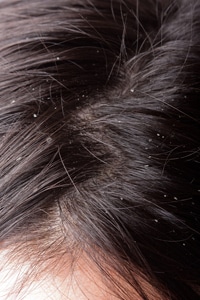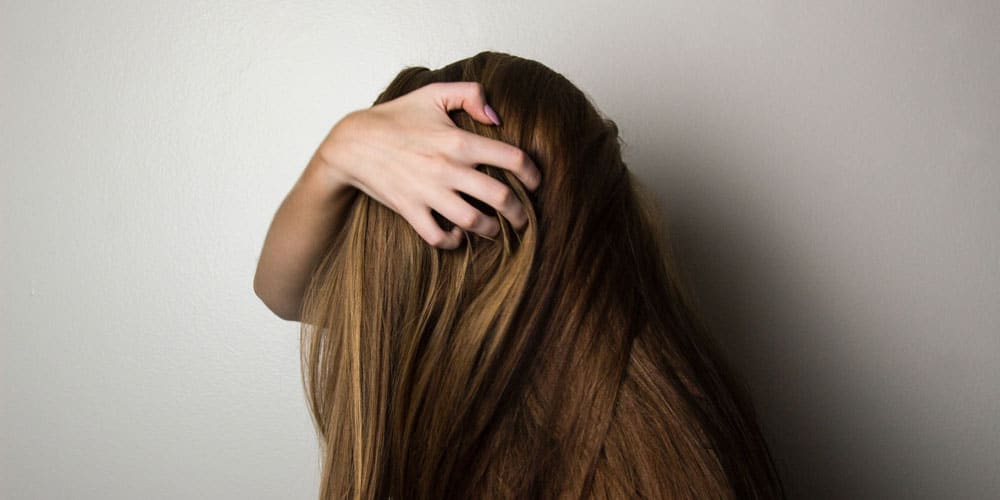Although we tend to associate dandruff with itchy scalp, this is not necessarily automatic. You can have itchy scalp without this being linked to the appearance of dandruff, and vice versa.
Apart from the purely aesthetic and unpleasant aspect of dandruff on a daily basis, this phenomenon can be a symptom of a more serious skin problem - such as seborrheic dermatitis: - and have lasting consequences on the health and beauty of the hair.
That's why it's important to make the right diagnosis and identify the type of dandruff you have in your hair, so you can choose the treatment best suited to the problem. In fact, the same treatment will not be recommended depending on the condition of the scalp, whether it is too dry or a little oily.
WHAT CAUSES DANDRUFF AND ITCHING?
While we now know the causes of dandruff, we still don't know why some scalps are more sensitive to it than others. Dandruff, like the itching that often accompanies it, corresponds to an abnormal activation of the dermal cells of the scalp and their expulsion by "desquamation" (elimination of the superficial layers of the epidermis in the form of small flakes or skin flakes "). This anomaly remains a mystery. However, there are now effective treatments and that's what it's all about.
Dandruff is caused by a microscopic organism: pityriasis*. This fungus present on all scalps remains generally inactive. Why does it start to proliferate on certain heads? Researchers still don't have the definitive answer. Some talk of a genetic and endocrine predisposition, others of the acidity of the scalp's pH triggering its proliferation.
What normally happens
Normally, the skin on the scalp, like that on the rest of the body, renews itself once a month. New cells form in the deep layers of the dermis, then eliminate the dead ones by pushing them outside the epidermis. This change takes place without our noticing, as it happens slowly and unsynchronously, unlike the moulting of certain animals.
What happens with pityriasis
When the fungus responsible starts to colonise the scalp, the whole local ecosystem goes haywire. Under its impetus, cell traffic accelerates and new cells form too quickly (in a fortnight, or even eight days), leaving no time for dead cells to dissolve imperceptibly, forcing them to clump together and accumulate on the surface of the scalp in the form of scales.
Pityriasis and sebum
Pityriasis feeds on fatty acids, which it naturally finds in the sebum secreted by the sebaceous glands. Does this mean that it only thrives on oily scalps ? It prefers them but can also proliferate on a dry scalp. In both cases, pityriasis in turn generates by-product acids that irritate the scalp (hence the itching). The body reacts to this irritation by further accelerating the cellular process, leading to the formation of dandruff - a vicious circle.
* This learned word comes from ancient Greek and literally means "floury darter"!
THE DIFFERENT TYPES OF DANDRUFF
Dry dandruff, the most common type

They detach spontaneously from the scalp and fall in varying amounts onto clothing. They appear more easily on normal or dry scalps. In this category, some dandruff is not due to pytiriasis but simply to an overly dry scalp whose chronic lack of sebum cracks the skin, like soil lacking water. This is the case, for example, with the scalps of African or mixed-race hair which are often very dry and lack moisture. On diagnosis, a specialist can tell the difference from dandruff due to pytiriasis: the scales are smaller and do not have the same appearance. It's important to tell the difference because standard anti-dandruff treatment will have no effect on this type of dandruff. This type of dandruff is almost always accompanied by itching, and the basic treatment is to moisturise the scalp with an emollient, soothing lotion, so that you no longer have a dry, intensely itchy scalp.
Even on a scalp that is not dry by nature, dry dandruff can occur with regular application of Minoxidil. Containing a high percentage of alcohol, this hair loss remedy can cause inflammation of the dermal cells, leading to dry dandruff and/or itching (pruritus). You need to apply a healing and moisturising lotion to stop your scalp itching because it's become too dry, dried out by repeated applications of Minoxidil or its derivatives.
Oily dandruff
More insidious, this type of dandruff appears on scalps that are too oily and stick to the head in patches of varying size. These patches, stuck in seborrhoea, encourage the formation of bacteria and often lead to irritation and severe itching. Not to be confused with psoriasis of the scalp or with seborrheic dermatitis:, which are much more incapacitating and cause intense itching.
WARNING: the idea that dandruff prevents the roots from breathing and blocks hair growth is false. Dandruff, whether loose or stuck on, can be an aggravating symptom of hair loss, but it does not trigger it.
If your hair is falling out too much, you need to look elsewhere for the cause and have the following established a hair diagnosis with an analysis of hair roots. Only this analysis will enable us to understand the origin of your hair loss and treat it accordingly.
WHAT INCREASES THE APPEARANCE OF DANDRUFF AND ITCHING
The factors involved are highly variable and often combine with each other. Digestive assimilation problems, for example, combined with over-detergent shampooing and aggressive blow-drying that leaves the scalp excessively dry, can encourage the proliferation of pityriasis.
INTERNAL FACTORS
- Overwork and stress
- Infection, high fever
- Hormonal imbalance
- Approach to rules
- Heavy periods
- Excessive sweating
- Digestive assimilation problems
- Overly acidic diet
EXTERNAL FACTORS
- Overly detergent shampoos
- Poorly rinsed hair after shampooing
- Aggressive brushing
- Dyes, straightening and perms
- Using too many gels or hairsprays on your hair
- Motorbike helmets
- Caps or hats that are too tight
- Temperatures (alternating cold outside and central heating inside)
WHAT WE RECOMMEND
How can you get rid of the dandruff and itching that can become a real handicap in your daily life? Here are a few ideas. Firstly, the anti-dandruff treatments on the market. Next, the natural Laits Clauderer that have been proven effective (see results below). And finally, a few "homemade" recipes for soothing itchy scalps in the event of a major crisis.
ANTI-DANDRUFF PRODUCTS ON THE MARKET
- ANTIFUNGICS: Reduce the number of fungi (zinc pyrithione, selenium sulphide).
- ANTIPROLIFERANTS: Do not act directly on the destruction of the fungus, but slow down the abnormal production of dermal cells (coal tar). Banned in France for the last twenty years.
- KERATOLYTICS: Break down the intercellular links so that the dead cells that reach the outside of the scalp are separated and no longer in scaly blocks (sulphur, salicylic acid).
CENTRE CLAUDERER'S SOLUTION FOR SOOTHING ITCHY SCALPS AND ELIMINATING DANDRUFF FOR GOOD
To look after your hair and your scalp, your Clauderer Specialist will recommend a personalised hair care programme with Laits Clauderer . These purifying and cleansing lotions will form the basis of your treatment to quickly and effectively reduce dandruff and itchy scalp. These lotions or 'Laits' are just as effective in combating "ordinary" dandruff as they are in soothing a suffering scalp during outbreaks of seborrhoeic dermatitis or psoriasis. Even if, of course, it's impossible to completely eradicate these 2 auto-immune diseases, the comfort they bring to the scalp is priceless!
These Laits which are highly effective and have no side effects, are ideal for moisturising the skin of a scalp that has become too dry, as well as for rebalancing a scalp that has become too dry. with an oily tendency. They're not shampoos, and they're not designed to wash the hair: they tackle the problem upstream, reaching the subcutaneous area of the scalp where dandruff and itching form. Their proven effectiveness* lies in a selection of highly penetrating essential oils and gentle plant oils combined with anti-inflammatory and purifying plant active ingredients. Depending on your scalp, your Specialist will mainly recommend Lait N°1R or Lait N°3R.
* Proven effective on 95% users, according to a study carried out on a sample of 100 Clauderer customers..
HOMEMADE RECIPES
Here are some recipes that work well for severe itching:
- Before shampooing, dissolve 100 mg of acetylsalicylic acid (aspirin) in a tablespoon of water and apply to the scalp. Aspirin helps to loosen dandruff and relieve itching. A warm, damp towel placed on the head before application helps it to penetrate.
- Lightly massage the scalp with lemon juice on the fingertips, without scratching. For frizzy scalps, mix lemon with olive oil or another vegetable oil (in the proportion 1/3 lemon, 2/3 vegetable oil).
CLAUDERER TIPS TO AVOID
DANDRUFF AND ITCHY SCALP
- Increased hygiene during periods of crisis. Although pityriasis is not contagious from one person to another, it is advisable to wash your hairbrush or comb often, as you can reinfect yourself.
- When you shampoo, give your hair a final rinse with a few drops of cider vinegar to cleanse your scalp and remove limescale from the water. As a bonus, your hair will be shinier!
- A sufficiently long period of time (at least 15 days) between a perm and a colour.
- Eat fresh fruit before or between meals to avoid gastric fermentation. Green vegetables (or steamed potatoes) at least once a day to make your diet less acidic.
- Vitamin treatment: provitamin A complex, vitamins E and C, selenium.
- Yes to anti-dandruff shampoos, but in moderation. Too much can have the opposite effect: it can irritate the skin.
- Choose your anti-dandruff treatment carefully, depending on the nature of your dandruff (dry or oily).
- When you wash your hair, only shampoo once if possible. A second shampoo unnecessarily sensitises your scalp, especially if you wash your hair often.
- Avoid vigorous massaging or rubbing when shampooing, on the pretext of eliminating dandruff. The boomerang effect is guaranteed as soon as the hair dries.
- On the other hand, carry out scalp massage. Before shampooing, use a cleansing lotion to thoroughly remove dandruff.
- Rinse your hair thoroughly. As it dries, the residue of poorly rinsed shampoo will clump together with sweat and sebum and quickly recreate an environment conducive to itching.
- Try to moderate your nervous tension. Stress encourages the proliferation of pityriasis, the fungus responsible for dandruff and flaking.
- Between 2 shampoos, lightly massage your itchy scalp with lemon juice on your fingertips, rather than scratching!
- Drink plenty of mineral water. Choose water with a neutral pH.
BEWARE OF AGGRAVATING FACTORS SUCH AS :
- When shampooing, do not use scouring products (under the pretext of eliminating dandruff), energetic massages (under the same pretext), or water that is too hard or too hot (no more than 37°C).
- Rinsing shampoos too quickly. As the shampoo dries, the cleansing agents, dust and sebum not eliminated by the water remain in contact with the skin, permanently damaging its pH.
- Regular use of anti-dandruff shampoos. Most shampoos are effective against pytiriasis, as long as you choose them according to the nature of your dandruff (dry or greasy). But use them sparingly. Excessive use of these shampoos can have the opposite effect to that intended: they can irritate the skin and devitalise the hair.
- Gels, foams or sprays containing alcohol (ethyl alcohol): they dry out and irritate the skin.
- Foods that tend to acidify the pH of the skin: too much coffee, sweets, dairy products or red meat, cold meats, etc.

